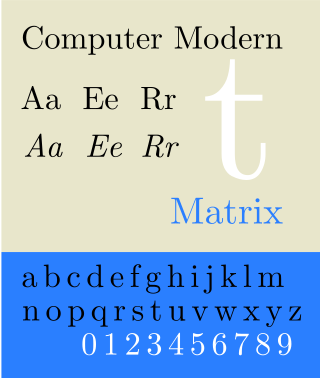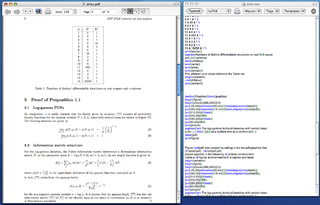TeX, stylized within the system as TeX, is a typesetting system which was designed and written by computer scientist and Stanford University professor Donald Knuth and first released in 1978. TeX is a popular means of typesetting complex mathematical formulae; it has been noted as one of the most sophisticated digital typographical systems.

The device independent file format (DVI) is the output file format of the TeX typesetting program, designed by David R. Fuchs and implemented by Donald E. Knuth in 1982. Unlike the TeX markup files used to generate them, DVI files are not intended to be human-readable; they consist of binary data describing the visual layout of a document in a manner not reliant on any specific image format, display hardware or printer. DVI files are typically used as input to a second program which translates DVI files to graphical data. For example, most TeX software packages include a program for previewing DVI files on a user's computer display; this program is a driver. Drivers are also used to convert from DVI to popular page description languages and for printing.

Computers and Typesetting is a 5-volume set of books by Donald Knuth published in 1986 describing the TeX and Metafont systems for digital typography. Knuth's computers and typesetting project was the result of his frustration with the lack of decent software for the typesetting of mathematical and technical documents. The results of this project include TeX for typesetting, Metafont for font construction and the Computer Modern typefaces that are the default fonts used by TeX. In the series of five books Knuth not only describes the TeX and Metafont languages, he also describes and documents the source code of the TeX and Metafont interpreters, and the source code for the Computer Modern fonts used by TeX. The book set stands as a tour de force demonstration of literate programming.

Computer Modern is the original family of typefaces used by the typesetting program TeX. It was created by Donald Knuth with his Metafont program, and was most recently updated in 1992. Computer Modern, or variants of it, remains very widely used in scientific publishing, especially in disciplines that make frequent use of mathematical notation.

TeXShop is a free LaTeX and TeX editor and previewer for macOS. It is licensed under the GNU GPL.

AMS Euler is an upright cursive typeface, commissioned by the American Mathematical Society (AMS) and designed and created by Hermann Zapf with the assistance of Donald Knuth and his Stanford graduate students. It tries to emulate a mathematician's style of handwriting mathematical entities on a blackboard, which is upright rather than italic. It blends very well with other typefaces made by Hermann Zapf, such as Palatino, Aldus and Melior, but very badly with the default TeX font Computer Modern. All the alphabets were implemented with the computer-assisted design system Metafont developed by Knuth. Zapf designed and drew the Euler alphabets in 1980–81 and provided critique and advice of digital proofs in 1983 and later. The typeface family is copyright by American Mathematical Society, 1983. Euler Metafont development was done by Stanford computer science and/or digital typography students; first Scott Kim, then Carol Twombly and Daniel Mills, and finally David Siegel, all assisted by John Hobby. Siegel finished the Metafont Euler digitization project as his M.S. thesis in 1985.
PSTricks is a set of macros that allow the inclusion of PostScript drawings directly inside TeX or LaTeX source code. It was originally written by Timothy Van Zandt and has been maintained in recent years by Denis Girou, Sebastian Rahtz and Herbert Voss.
The PracTeX Journal, or simply PracTeX, also known as TPJ, was an online journal focussing on practical use of the TeX typesetting system. The first issue appeared in March 2005. It was published by the TeX Users Group and intended to be a complement to their primary print journal, TUGboat. The PracTeX Journal was last published in October 2012.
Inverse search is a feature of some non-interactive typesetting programs, such as LaTeX and GNU LilyPond. These programs read an abstract, textual, definition of a document as input, and convert this into a graphical format such as DVI or PDF. In a windowing system, this typically means that the source code is entered in one editor window, and the resulting output is viewed in a different output window. Inverse search means that a graphical object in the output window works as a hyperlink, which brings you back to the line and column in the editor, where the clicked object was defined. The inverse search feature is particularly useful during proofreading.

Asymptote is a descriptive vector graphics language — developed by Andy Hammerlindl, John C. Bowman, and Tom Prince — which provides a natural coordinate-based framework for technical drawing. Asymptote runs on all major platforms. It is free software, available under the terms of the GNU Lesser General Public License (LGPL).
The Cork encoding is a character encoding used for encoding glyphs in fonts. It is named after the city of Cork in Ireland, where during a TeX Users Group (TUG) conference in 1990 a new encoding was introduced for LaTeX. It contains 256 characters supporting most west and east-European languages with the Latin alphabet.
Jim Hefferon is a Professor of Mathematics at Saint Michael's College. He is known for his award-winning textbook on linear algebra that is available for free download, with LaTeX source, and for his activity in the TeX community.
FarsiTeX is a free Persian/English bidirectional typesetting system based on the TeX system. The FarsiTeX project was initiated by Mohammad Ghodsi at Sharif University of Technology in 1993.

TeX Live is a cross-platform, free software distribution for the TeX typesetting system that includes major TeX-related programs, macro packages, and fonts. It is the replacement of its no-longer supported counterpart teTeX. It is now the default TeX distribution for several Linux distributions such as openSUSE, Fedora, Debian, Ubuntu, Termux and Gentoo. Other Unix operating systems like OpenBSD, FreeBSD and NetBSD have also converted from teTeX to TeX Live.

PGF/TikZ is a pair of languages for producing vector graphics from a geometric/algebraic description, with standard features including the drawing of points, lines, arrows, paths, circles, ellipses and polygons. PGF is a lower-level language, while TikZ is a set of higher-level macros that use PGF. The top-level PGF and TikZ commands are invoked as TeX macros, but in contrast with PSTricks, the PGF/TikZ graphics themselves are described in a language that resembles MetaPost. Till Tantau is the designer of the PGF and TikZ languages. He is also the main developer of the only known interpreter for PGF and TikZ, which is written in TeX. PGF is an acronym for "Portable Graphics Format". TikZ was introduced in version 0.95 of PGF, and it is a recursive acronym for "TikZ ist kein Zeichenprogramm".
In digital typography, the New Typesetting System (NTS) is a discontinued reimplementation of the typesetting system TeX in Java. The specific aims of the project were to continue the tradition of Donald Knuth's TeX by providing a first-class typesetting software which is both portable and available free of charge. But whereas TeX is now frozen due to maximum stability, NTS was intended to remain flexible and extensible.
The computer program AmigaTeX is a port of Knuth's typesetting program TeX, and was originally written in WEB and translated to C by Tomas Rokicki. This translation was necessary because of the lack of a suitable Pascal compiler for the Amiga computer.
The CS Indic character set, or the Classical Sanskrit Indic Character Set, is used by LaTeX represent text used in the Romanization of Sanskrit. It is used in fonts, and is based on Code Page 437. Extended versions are the CSX Indic character set and the CSX+ Indic character set.
The CSX Indic character set, or the Classical Sanskrit eXtended Indic Character Set, is used by LaTeX represent text used in the Romanization of Sanskrit. It has no association with American railroad company CSX Transportation. It is an extension of the CS Indic character set, and is based on Code Page 437. An extended version is the CSX+ Indic character set. Michael Everson made a font in this character set for the Macintosh.
The CSX+ Indic character set, or the Classical Sanskrit eXtended Plus Indic Character Set, is used by LaTeX to represent text used in the Romanization of Sanskrit. It is an extension of the CSX Indic character set, which in turn is an extension of the CS Indic character set, and is based on Code Page 437. It fixes an issue with Windows programs, by moving á from code point 160 (0xA0), to code point 158 (0x9E).








